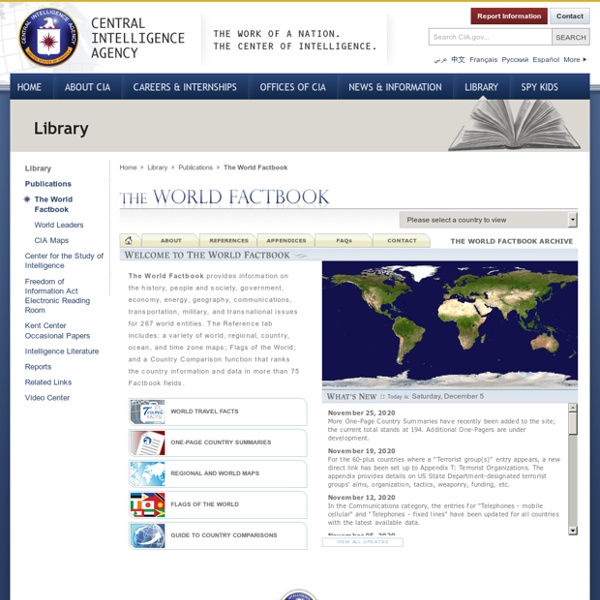



Country Briefings EN IMAGES. Une carte du monde montre les pays à leur "vraie" taille contrairement aux planisphères classiques GÉOGRAPHIE - Méfiez-vous des apparences trompeuses... Lorsque l'on regarde un planisphère établi sur la base de la projection de Mercator, certains pays – tels que le Brésil ou encore la Russie – peuvent paraître immenses. Créée par James Talmage et Damon Maneice, cette carte apparaît comme un grand bouleversement de notre représentation du monde: depuis notre plus tendre enfance, nous avons en effet été accoutumés à utiliser des mappemondes obéissant à la Projection Mercator. Si cette dernière possède pour avantage de représenter le monde entier au sein d'une carte rectangulaire, elle ne permet cependant pas de conserver les proportions réelles des pays: plus ils se trouvent près des pôles et plus ils sont représentés grands. Contrairement à ce qu'on pourrait penser en regardant une carte traditionnelle donc, la Russie par exemple, n'est pas plus grande que le continent africain.
UNdata Hybrid and Postcolonial Music Ethnomusicology Bruno Nettl, a music and anthropology professor, lists some of the various definitions for “ethnomusicology.” Meanings, in terms of the material that is studied, range from “folk and what used to be called “primitive,” i.e. tribal or possibly ancient music,to “all human music” (The Study of Ethnomusicology, 2-3). Colonialism and the Production of Hybrid Culture Colonialism affected the people who were colonized economically, socially, and politically. Responses to Western Influences Nettl cites three types or groups of motivation for non-Western societies in relation to their experience of colonization or the formation of cultural hybridity as expressed in their musical behavior in an essay entitle “Cultural Grey-Out” (The Study of Ethnomusicology, 347-48). Hybrid Music Forms In addition to Westernization, one must also consider the influence that the colonies have had on Western culture. Miho Hatori, vocalist for the band Cibo Matto/CC Licensed
World Wealth Report 2011 Wealth and population of global HNWIs surpass pre-crisis levels in nearly every region as HNWI wealth reaches US$42.7 trillion The world’s high net worth individuals (HNWIs) expanded in population and wealth in 2010 surpassing 2007 pre-crisis levels in nearly every region, according to the 15th annual World Wealth Report from Merrill Lynch Global Wealth Management and Capgemini. The World Wealth Report covers 71 countries in the market-sizing model, accounting for more than 98% of global gross national income and 99% of world stock market capitalization. The report has built a strong and lasting reputation as the industry benchmark for HNWIs market sizing—originally at a global and regional level but increasingly at a country level. Download the Report to learn more about trends in HNWI wealth worldwide. The report is available in English, Simplified Chinese, Traditional Chinese and Japanese.
OECD How To Learn On Your Own: Make A Personal Scholar Resource Plan One of the most challenging and gratifying parts of learning alone is the opportunity to search for and select your own learning material. Students in traditional classrooms usually don’t get to decide how they are going to master course content. Instructors decide for them in the form of textbook selection, quizzes, tests, group projects, etc. A resource plan is a document used to brainstorm the learning material you can use when you begin your studies. This article will show you how to create a resource plan to use in your independent studies. Step 1: Set a Goal The first step to creating a resource plan is to decide on a single goal. Ineffective Goal – Learn HTMLEffective Goal – Create several websites using HTML, referring only minimally to a coding book. Ineffective Goal – Learn about American literature.Effective Goal – Identify and read 100 classic American novels, memorize the major time periods in American literature, and be able to discuss major American authors.
IMF Data World Economic Outlook Databases (WEO) Updated Download time series data for GDP growth, inflation, unemployment, payments balances, exports, imports, external debt, capital flows, commodity prices. More International Financial Statistics (IFS) More IMF Statistics Data Provides comprehensive access to IFS, BOPS, DOTS, GFS and free access to a range of additional IMF datasets. Data Portal Principal Global Indicators (PGI) A website that brings together data for the major economies available from international agencies covering the financial, governmental, external, and real sectors, and provides links to data in web sites of international and national agencies. More Global Housing Watch A website that tracks developments in housing markets around the world. More Balance of Payments Statistics (BOPS) More Capital Flow Management Measures Taxonomy New Download PDF Download Excel Coordinated Direct Investment Survey (CDIS) New More Coordinated Portfolio Investment Survey (CPIS) New More More More More More More